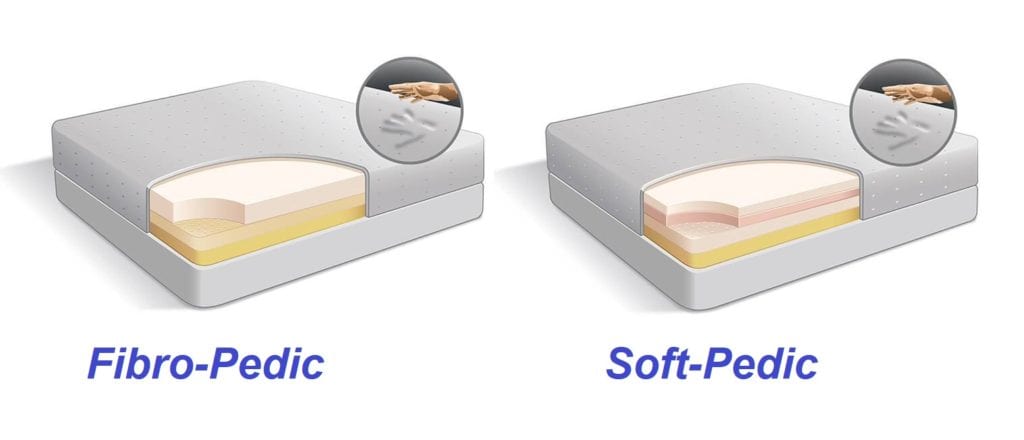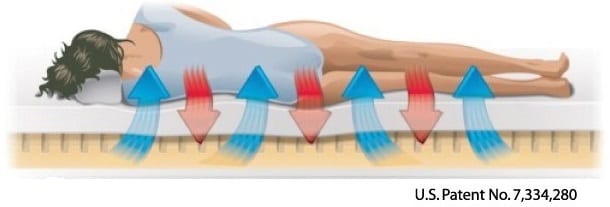
The First Latex Mattresses
Latex (then called “foam rubber”) was used in mattresses before memory foam mattresses were invented. Since it is springy, latex bounces back into shape when the user gets off. This was a big improvement over cotton padding, but was expensive, at least before World War II which stirred the widespread use of less costly synthetic rubber, and modern rubber plantations plus modern shipping, which reduced the transportation cost of natural latex from rubber trees. Here is a brief history of latex in mattresses:
- In 1931, Dunlop Tyre and Rubber Company sold the first latex mattress, made with the firm’s Dunlopillo® foam rubber.
- In 1935, latex mattresses were made and sold to Sears, Roebuck & Co. by Ansil Talalay and Joseph Leon, who later developed the Talalay process.
- In the 1950s, the Foamex division of Firestone advertised its foam rubber mattress. This may have been made of synthetic (styrene-butadiene) rubber, which had been developed just before World War II.
A Different Feel
Then came memory foam. Also called “visco-elastic foam” or just “visco,” it is valued for its conformity, which relieves pressure on larger joints. Memory foam, developed from polyurethane foam, has a different feel. It cradles the user by giving in and holding its shape, while springy latex sinks only a little way in.
It is repeatedly said that you lie in memory foam and on latex.
Special Considerations
We now have many kinds of mattresses, foundations, and pillows to choose from. All are intended to meet two general considerations: getting a good night’s sleep and correct spinal alignment. Along the way are special considerations to be met, such as sleep apnea, gastric reflux, and pre-existing spinal problems. Other special considerations are fibromyalgia, briefly described as generalized pain, and joint pain (arthritis, bursitis, and tendonitis). For many persons with these conditions, memory foam’s pressure relief is not enough.
A New Solution
Selectabed, the sleeping products division of Relief-Mart, began with designing and making memory foam mattresses. They developed the multi-layer memory foam mattress with two comfort layers using different densities of memory foam. This was a dual solution to memory foam’s heat retention and a slow initial response while still relieving pressure.
Selectabed’s solution to these was a memory foam/latex hybrid. Two models are Fibro-Pedic and Soft-Pedic. This balances the conformity and memory of memory foam with the springiness and quick response of latex. They also had a latex mattress without memory foam, the Taluxe (discontinued in 2018).
Imitation is a form of honest flattery. Many newer mattresses, such as the original Casper Mattress, combine latex or latex-like foams with memory foam to provide the same benefits.
Customization
Selectabed Latex Mattresses are made to order, as are all their other mattresses. For this reason, the prices listed are only suggested in-store and online prices. Customization means that adjustments are made for the individual customer at the time of assembly. This can include additional features, such as the height of the support core or inclusion of newer materials, such as Biogreen Memory Foam.
Sleep Trial and Warranty
The sleep trial for the Selectabed Latex Mattresses is 120-days, longer than for most other memory foam and/or latex mattresses. For instance, most traditional brands have 90-day sleep trials, while those of many of the start-ups are for 100 or 101 nights. This is also an adjustment period when changes can be made to the mattress, such as for a different firmness level or a variation in material.
These mattresses are covered by a 20-year warranty, twice the now-standard 10 years for most other brands of memory foam mattresses and latex mattresses, including TEMPUR-Pedic and Casper Sleep.
Optional Feature: Airflow Transfer System
The Airflow Transfer System is an available option for Selectabed mattresses, including Latex Mattresses. Although open-cell memory foam is now the standard for most memory foam mattresses and pillows (the original memory foam was closed-cell foam), better airflow is needed for efficient cooling. Airflow is also the key to all-night cooling with gel, since it otherwise becomes heat-saturated and no longer able to siphon off heat.

How It Works
The visible component of the Airflow Transfer System is the Kool-Flow cover, which lets air freely enter and exit the mattress though its knitted-in Micro-Vents, both on top and on the sides. Then the internal structure of the mattress lets air flow through. The upper layers are vertically ventilated with numerous perforations. Horizontal channels cut into the top surface of the base layer let air flow horizontally to the sides. This lets heated air flow down and out, and cool air flow in and up.
Airflow not only cools the mattress, it also controls moisture, inhibiting the growth of mold and bacteria.
Customer Response
We calculate our ratings in accordance with our Verified Review Policy.
The Fibro-Pedic and Soft-Pedic latex-memory foam mattresses are sold only in the Selectabed store and online from Selectabed’s website. Then these are mattresses made for specific conditions. This limits the availability of customer reviews, such as on Amazon and other retail sites. Five potential sources of reviews and ratings by Selectabed customers are Viewpoints, Reseller Ratings, Yelp, Beds.Org, and Goodbed. Among these sources, only Reseller Ratings has customer reviews which name these two models. Beds.Org has a staff review of each model, but no customer reviews. The other three sites have reviews of Selectabed mattresses, but not of these two.
Another rating source is Sleep Like the Dead. However, it summarizes online reviews and comments by mattress owners rather than posting individual reviews. Among Selectabed mattresses, Air-Pedic is covered, but not these two models.
Other sources of potential reviews are independent bed testers/reviews and writers who happen to own or have tried the mattress in question. For Fibro-Pedic and Soft-Pedic, there are a few of these.
Reseller Ratings
Out of the 91 reviews on Reseller Ratings of Selectabed, only six named Latex Mattresses: four the Fibro-Pedic and two the Soft-Pedic. All were 5-star ratings. One Fibro-Pedic reviewer complimented the sales personnel and was waiting for delivery of the mattress, and another only reviewed the shopping experience. The other two and those reviewing the Soft-Pedic rated their mattresses. This is a 5.0 average rating. However, such a small sample is only indicative at best. On the plus side, we should note that these reviews cover more than a 2½-year period, showing consistency.
Other Evaluative Sources
The Sleep Disorders Center of Alabama has furnished its diagnostic sleep rooms with Selectabed mattresses, half with the Tri-Pedic and half with the Fibro-Pedic. This was after researching and testing several brands and models. They have had a good response from their patients. A conservative estimate of their rating would be 4.7.
A New Life Outlook article, Choosing a Mattress for Fibromyalgia, recommends Tempur-Pedic, Fibro-Pedic, and Sleep Number. The remarks cite Tempur-Pedic’s variety of firmnesses to choose from, Sleep Number’s adjustability, and Fibro-Pedic being specially designed for fibromyalgia sufferers. One was not rated above the others, but the special design seems to give Fibro-Pedic an edge. A conservative rating would be 4.6.
On the blog ButYouDontLookSick, Christine Miserandino writes not as a reviewer who tests mattresses, but as someone with fibromyalgia who actually uses the mattress. After it has helped her to get restorative sleep with relief from pain, she highly recommends consideration of the Fibro-Pedic. Even without a number, this is written like a 5-Star review.
An Aggregate Rating
In accordance with our rating guidelines, we are not calculating an aggregate rating fo Selectabed Latex Mattresses because there are too few customer ratings for a reliable rating.
Pros & Cons
Owners commented that the Fibro-Pedic and Soft-Pedic mattresses provided both the soft surface and the underlying support they needed. Owners included an 87-year old who was “able to rest and sleep comfortably” on the Fibro-Pedic, and an obstetrics doctor who “felt immediate pressure reduction on my hips and was able to sleep better than ever!” on the Soft-Pedic. No cons were stated for either of these models.
Averaging these yields an average rating of 4.9 stars (97%).
Additional Information
Follow the links below for more detail on individual Selectabed latex mattress models:

